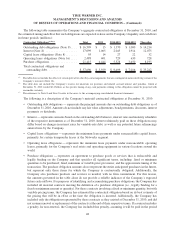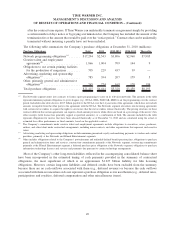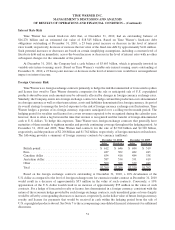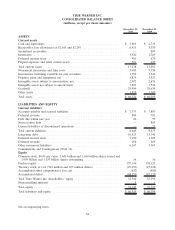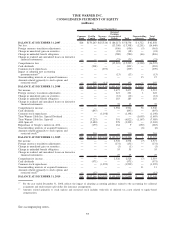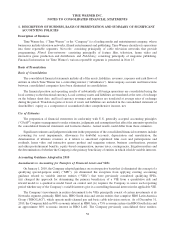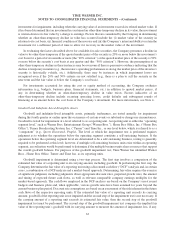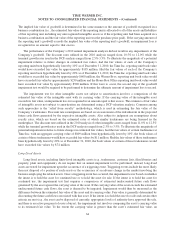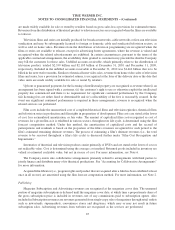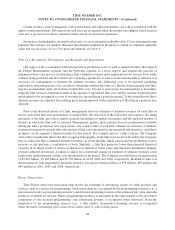Time Magazine 2010 Annual Report Download - page 70
Download and view the complete annual report
Please find page 70 of the 2010 Time Magazine annual report below. You can navigate through the pages in the report by either clicking on the pages listed below, or by using the keyword search tool below to find specific information within the annual report.TIME WARNER INC.
NOTES TO CONSOLIDATED FINANCIAL STATEMENTS
1. DESCRIPTION OF BUSINESS, BASIS OF PRESENTATION AND SUMMARY OF SIGNIFICANT
ACCOUNTING POLICIES
Description of Business
Time Warner Inc. (“Time Warner” or the “Company”) is a leading media and entertainment company, whose
businesses include television networks, filmed entertainment and publishing. Time Warner classifies its operations
into three reportable segments: Networks: consisting principally of cable television networks that provide
programming; Filmed Entertainment: consisting principally of feature film, television, home video and
interactive game production and distribution; and Publishing: consisting principally of magazine publishing.
Financial information for Time Warner’s various reportable segments is presented in Note 15.
Basis of Presentation
Basis of Consolidation
The consolidated financial statements include all of the assets, liabilities, revenues, expenses and cash flows of
entities in which Time Warner has a controlling interest (“subsidiaries”). Intercompany accounts and transactions
between consolidated companies have been eliminated in consolidation.
The financial position and operating results of substantially all foreign operations are consolidated using the
local currency as the functional currency. Local currency assets and liabilities are translated at the rates of exchange
on the balance sheet date, and local currency revenues and expenses are translated at average rates of exchange
during the period. Translation gains or losses of assets and liabilities are included in the consolidated statement of
shareholders’ equity as a component of accumulated other comprehensive income, net.
Use of Estimates
The preparation of financial statements in conformity with U.S. generally accepted accounting principles
(“GAAP”) requires management to make estimates, judgments and assumptions that affect the amounts reported in
the consolidated financial statements and footnotes thereto. Actual results could differ from those estimates.
Significant estimates and judgments inherent in the preparation of the consolidated financial statements include
accounting for asset impairments, allowances for doubtful accounts, depreciation and amortization, the
determination of ultimate revenues as it relates to amortized capitalized film costs and participations and
residuals, home video and interactive games product and magazine returns, business combinations, pension
and other postretirement benefits, equity-based compensation, income taxes, contingencies, litigation matters and
the determination of whether the Company is the primary beneficiary of entities in which it holds variable interests.
Accounting Guidance Adopted in 2010
Amendments to Accounting for Transfers of Financial Assets and VIEs
On January 1, 2010, the Company adopted guidance on a retrospective basis that (i) eliminated the concept of a
qualifying special-purpose entity (“SPE”), (ii) eliminated the exception from applying existing accounting
guidance related to variable interest entities (“VIEs”) that were previously considered qualifying SPEs,
(iii) changed the approach for determining the primary beneficiary of a VIE from a quantitative risk and
reward model to a qualitative model based on control and (iv) requires the Company to assess each reporting
period whether any of the Company’s variable interests give it a controlling financial interest in the applicable VIE.
The Company’s investments in entities determined to be VIEs principally consist of certain investments at its
Networks segment, primarily HBO Asia, HBO South Asia and certain entities that comprise HBO Latin America
Group (“HBO LAG”), which operate multi-channel pay and basic cable television services. As of December 31,
2010, the Company held an 80% economic interest in HBO Asia, a 75% economic interest in HBO South Asia and
an approximate 80% economic interest in HBO LAG. The Company previously consolidated these entities;
58


